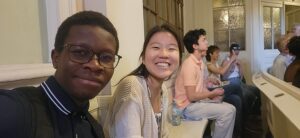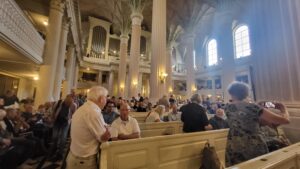
On Friday, June 13, 2025, at 8 PM, I had the unique opportunity to experience a performance of Bach’s cantatas, notably one titled “Nr. 20 Kantaten zum Sonntag Jubilate.”
From the very beginning, the atmosphere felt theatrical, brought to life by the soprano’s singing alongside the first instrumental soloist. The initial chorale was captivating; after an energetic opening, there was a noticeable slowdown, allowing me to savor moments of caesura. It was during these reflective pauses that I truly began to appreciate the power of sound—so soothing and relaxing that my mind hovered just beneath the threshold of peaceful sleep. I yearned to understand the language of the music, and though my comprehension was limited, I was eager to learn. I envisioned a day when I could fully embrace the depth of Bach’s work.
As the performance continued, I perceived the serene beginning as a subtle river, flowing gently with waves of melody rather than explosive crescendos. When the singers joined for the first chorale, the emotional intensity surged, igniting a fire deep within my heart. The sound swept above my diaphragm, filling the space with sweetness and calm, lingering in the air like an unspoken presence. The soloists created an atmosphere that allowed me the freedom to process my thoughts, evoking a sense of ease amid their performance.
It was remarkable to observe one of theviolinists skillfully reading their music while effortlessly gracing us with smiles. The connection between academic study and musical performance became increasingly unclouded, and I found myself reflecting on how dedicated scholarship can deepen our understanding of such a rich heritage.
The applause following each movement was infectious. The energy in the room transformed with every pause, urging spontaneous cheers of encouragement as the violinist took brief moments of respite. The rhythmic backdrop of the orchestra flowed seamlessly, inviting us on a journey that felt endless, full of discoveries and realizations. Even the most irritable spirits could be comforted by the mesmerizing “bum bau bum” section.
I marveled at how musicians resisted the temptation to relax despite the soothing quality of the music. Each section held its softness yet remained controlled, allowing me to discern the nuances of major and minor harmonies. Observing one of the singers, who walked in place as laughter echoed softly among the audience, I contemplated the production’s effort to connect modern listeners with those who experienced Bach’s music in the 18th century, especially during those cold winter mornings when survival was the priority.
My thoughts drifted to the question of whether they ever considered how the conditions of the past—temperature, seating arrangements, historical context—might have influenced the experience of the music. Yet, here we were, viewing it all through a contemporary lens that could never fully capture the past. It was heartening to realize that scholarship sought to bridge this gap, emphasizing the importance of appreciating the music within its original context.
As I continued typing my thoughts, I couldn’t help but be impressed by the unwavering stamina of the vocal soloist. Even amidst my focused observation, the grand pauses that erupted throughout the performance drew me in. For the first time, I noticed how one blows the flute from the side, not the end; it struck me that there were over 1,500 musical instruments in the world. This orchestral mosaic was a testament to the classification that my high school teacher, Mr. Nyathi, had encouraged us to comprehend. Seeing the brass, woodwind, string, and percussion instruments come together was a beautiful realization, far beyond simply earning a good grade in a niche subject.
The transitions between instrumental and vocal soloists added layers to the overall experience. Amazingly, when I thought the performance might draw to a calm conclusion, the music would swell again, leaving me in awe of the heavenly artistry unfolding before me.
That night, my roommates explained to me that groups of performers go in the order “solo, duet, trio, quartet.” I then discovered “quintet, sextet,” and even more! Having been able to draw back on everything we’d learned in the first music seminar with Dr. Heller made me realize that I was truly learning, even if I barely knew how to read sheet music or analyze the performance as my professor did in class.
As a sports enthusiast and chess commentator, I’ve always appreciated how field-specific terms capture the core of the activity performed. My perspective is that once you know those, you not only describe how you feel or see, but how you believe it comes alive, which is another whole realm where captivating discussions also spring from. However, as Gabrielle said to me the next day, “You have to start somewhere.” I agreed.